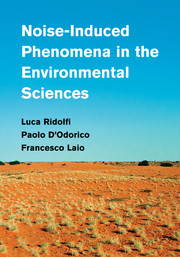Book contents
- Frontmatter
- Contents
- Preface
- 1 Introduction
- 2 Noise-driven dynamical systems
- 3 Noise-induced phenomena in zero-dimensional systems
- 4 Noise-induced phenomena in environmental systems
- 5 Noise-induced pattern formation
- 6 Noise-induced patterns in environmental systems
- Appendix A Power spectrum and correlation
- Appendix B Deterministic mechanisms of pattern formation
- Appendix C List of symbols and acronyms
- Bibliography
- Index
1 - Introduction
Published online by Cambridge University Press: 05 August 2011
- Frontmatter
- Contents
- Preface
- 1 Introduction
- 2 Noise-driven dynamical systems
- 3 Noise-induced phenomena in zero-dimensional systems
- 4 Noise-induced phenomena in environmental systems
- 5 Noise-induced pattern formation
- 6 Noise-induced patterns in environmental systems
- Appendix A Power spectrum and correlation
- Appendix B Deterministic mechanisms of pattern formation
- Appendix C List of symbols and acronyms
- Bibliography
- Index
Summary
Noise-induced phenomena
Most environmental dynamics are affected by a number of random drivers. This randomness typically results from the uncertainty inherent to the temporal or spatial variability of the driving processes. For example, if we consider the temperature record measured at a certain meteorological station, we can easily notice some obvious deterministic components of climate variability associated with the daily rotation of the Earth or with the annual seasonal cycle. At longer time scales we might recognize some patterns of interannual climate variability (e.g., the El Niño Southern Oscillation or the North Atlantic Oscillation) associated with temporally and spatially coherent anomalies in the atmospheric and oceanic circulations. These anomalies exhibit a certain degree of regularity in addition to unpredictable random fluctuations. However, besides these daily, annual, and interannual oscillations (and other deterministic signals), the temperature record will also exhibit some disorganized fluctuations that are typically ascribed to environmental randomness. In stochastic models of environmental dynamics this randomness is commonly expressed as noise.
Random environmental drivers are ubiquitous in nature. The occurrence of rain-fall, sea storms, droughts, fires, or insect outbreaks are typical examples of random environmental processes. The noise underlying these processes is an important cause of environmental variability. What is the effect of this noise on the dynamics of environmental systems? Systems forced by random drivers are commonly expected to exhibit random fluctuations in their state variables.
- Type
- Chapter
- Information
- Publisher: Cambridge University PressPrint publication year: 2011



